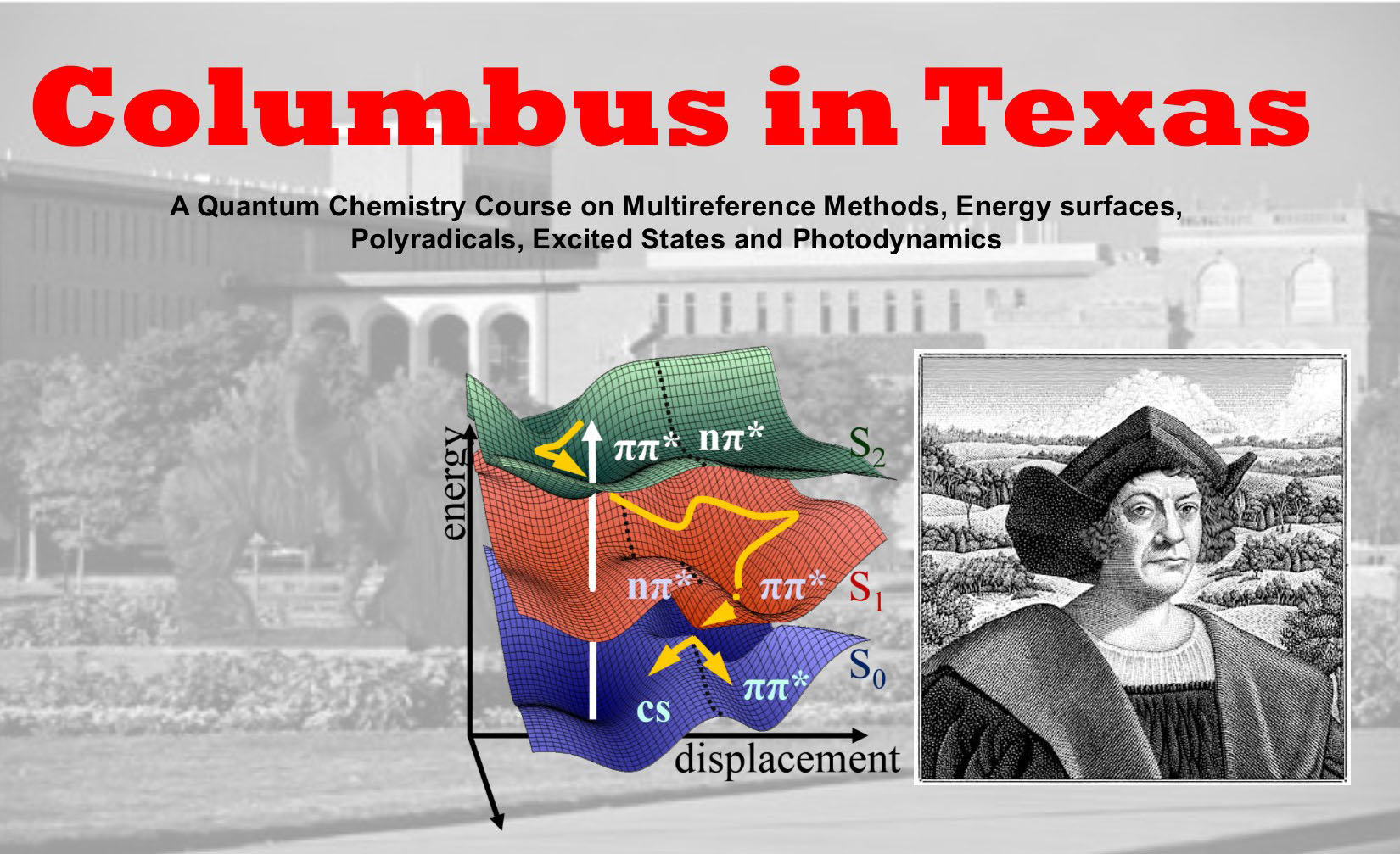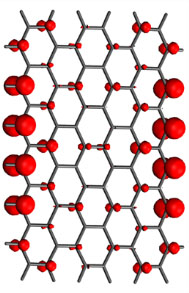Columbus in Texas
A Quantum Chemistry Course
Multireference Methods, Energy surfaces, Polyradicals, Excited States and Photodynamics
Location: Texas Tech University, Texas
Date: May 18 – May 22, 2015
The goal of the present course is to introduce the concepts of multireference theory
and their application to several interesting fields of chemistry and molecular physics.
Special emphasis will be placed on the calculation of energy surfaces and electronic
properties of ground- and excited states, conical intersections and introductory ab initio dynamics. This course will be divided into lectures and practical application work
based on the COLUMBUS program system. The latter will be organized in small working
groups. Columbus in Texas is aimed at interested advanced students as well as scientists at all levels.
Organizers: Hans Lischka, Adelia Aquino and Michael San Francisco
Speakers: Mario Barbatti, Felix Plasser, Ron Shepard, Peter G. Szalay

Columbus in Texas
A Quantum Chemistry Course on Multireference Methods
Computational Chemistry and Quantum Chemistry in particular have become important fields of research which have extended into all areas of Chemistry, Molecular Biology and Material Science. The Quantum Mechanical methods used are based on the Schroedinger equation which allows a detailed atomistic description of molecular processes. The solution of this equation is difficult and numerical methods have been developed which require extensive computer power. Several classes of methods have been developed which different ranges of application. One of the most general classes encompasses multireference methods [1] which allow comprehensive investigations of chemical reactions, photochemical processes and material properties.
The methods used require a thorough understanding of the electronic structure of molecules and the theoretical methods used. The COLUMBUS system (http://www.univie.ac.at/columbus/) is one of the few computer programs that are dedicated to such calculations [2]. It is based on the multireference configuration interaction (MRCI) method and has worldwide unique features in terms of computational methods concerning analytic energy gradients and nonadiabatic interactions between different electronic states.

Figure 1: Scheme showing several coupled energy surfaces with conical intersections and possible photodynamical reaction pathways.
Figure 1 shows a schematic representation of coupled energy surfaces and a possible
deactivation scheme which starts with light absorption in the ground state and a reaction
pathway which finally leads back to the point of origin. The existence of such pathways
is extremely important for biological processes. E.g. the photostability of DNA nucleobases
strongly depends on the existence of this scheme. Otherwise, the absorption of the
solar UV light can lead to deleterious damages of the genetic code. Interesting computer
simulations using the COLUMBUS program have been made [3] showing for the first time
by means of photodynamical simulations the concrete existence of the pathways explaining
the photostability of DNA nucleobases.
Another example where multireference calculations are important is given by the need
of band gap engineering of graphene. Graphene's many remarkable physical, thermal
and electrical properties with interesting applications in electronics, optoelectronics
and photonics have made it an object of intense research since it was first successfully
isolated in 2004 from graphite using the Scotch-Tape method [4]. Graphene is a special
allotrope of carbon composed of a two-dimensional lattice of fused benzene rings.
Graphene is looked to in particular for its potential to replace silicon in electronics.
Graphene nanosheets are highly reactive at its edges and it is important to know its
chemical properties in detail.
Goals and Previous Achievements
Figure 2 demonstrates this high reactivity at the zig zag edge of a nanosheet [5] by means of the unpaired density distribution calculated with the COLUMBUS program. This is another example where the use of multireference methods is crucial.
The goal of the course "Columbus in Texas" is to teach the basics and the application of multireference methods to advanced students and scientists. Even though there are Quantum Chemistry courses taught at several levels in the standard curricula of natural sciences, multireference methods usually do not get sufficient attention. It is the objective of this course to fill this gap. This course has already been given twice to audiences in different countries ("Columbus in Rio", Nov. 27-Dec.2, 2005, Rio de Janeiro, Brazil; "Columbus in Bangkok", Apr. 2-5, 2006, Bang Saen, Thailand), each time with about 50 participants, mostly students.

Figure 2. Unpaired electron density located at the zig zag edge of a periacene graphene nanosheet.
Outline of the Course
The course will be divided into two parts. In the first part the theoretical background
of the different theoretical methods will be presented. The second part is dedicated
to hands-on work on practical examples in order to learn the preparation of COLUMBUS
input, running jobs and analyzing results. The combination of the two steps is considered
as very important as it allows the direct practical application of the theoretical
formalisms.
In addition to the applicants four outstanding scientists will be available for giving
the classes and conducting the application work: Ron Shepard (Argonne National Laboratory,
USA) is an expert in the Unitary Group Approach on which COLUMBUS is based, Peter
G. Szalay (Eötvös Loránd University, Budapest, Hungary) has developed the averaged
quadratic coupled cluster method of COLUMBUS, Mario Barbatti (Max-Planck Institute
für Kohlenforschung, Germany) is an expert in photodynamics and Felix Plasser (Ruprecht-Karls-University
Heidelberg, Germany) is a specialist in the calculation of excited states and their
analysis.
The duration of the course is planned for five full days with up to 50 participants. The focus of participants will be laid on US students and scientists, but it is planned to announce the course internationally.
References
- P. G. Szalay, Th. Müller, G. Gidofalvi, H. Lischka and R. Shepard, Multiconfiguration Self-Consistent Field and Multireference Configuration Interaction Methods and Applications, Chem. Rev. 112 (2012) 108-181
- H. Lischka, Th. Müller, P. G. Szalay, I. Shavitt, R. M. Pitzer and R. Shepard, COLUMBUS – A Program System for Advanced Multireference Theory Calculations, Wiley Interdisciplinary Reviews: Computational Molecular Science (WIREs:CMS), W. Allen Ed., 1 (2011), 191-199
- M. Barbatti, A. J. A. Aquino, J. J. Szymczak, D. Nachtigallová, P. Hobza, and H. Lischka, On the relaxation mechanisms of UV-photoexcited DNA and RNA nucleobases, Proc. of the Nat. Acad. Science USA 107 (2010) 21453–21458
- Geim, A. K.; Novoselov, K. S. "The Rise of Graphene" Nat. Mater. 6 (2007), 183–191
- F. Plasser, H. Pašalić, M. H. Gerzabek, F. Libisch, R. Reiter, J. Burgdörfer, Th. Müller, R. Shepard and Hans Lischka, The Multiradical Character of One- and Two-Dimensional Graphene Nanoribbons, Angew. Chemie, Int. Edition, 52 (2013) 2581-2584
Honors College
-
Address
McClellan Hall, Box 41017 Lubbock, TX 79409-1017 -
Phone
806.742.1828 -
Email
honors@ttu.edu
